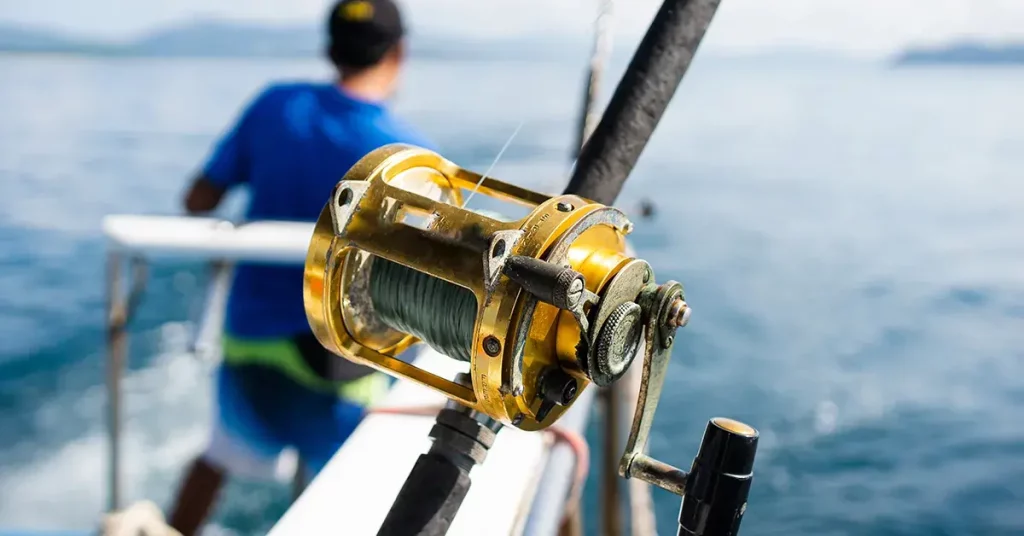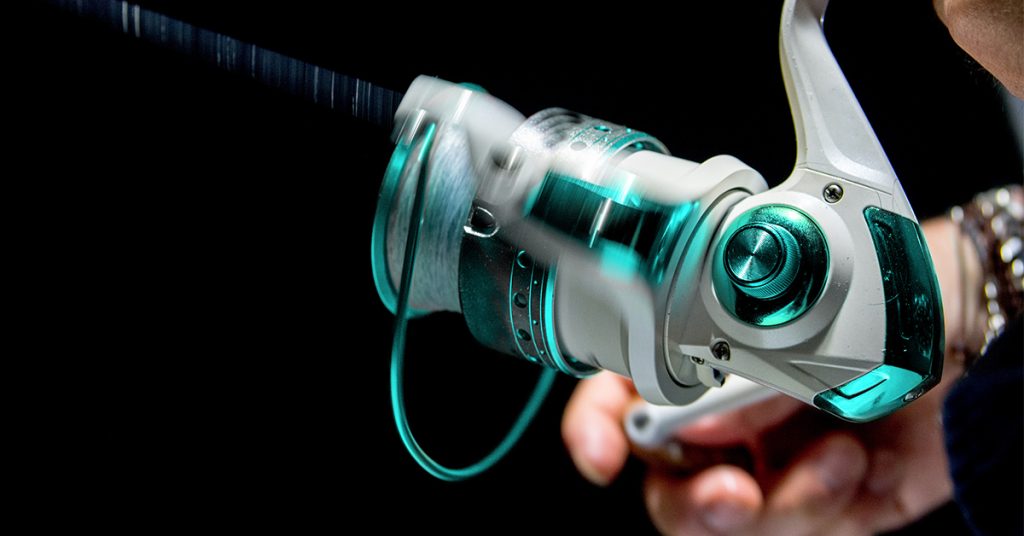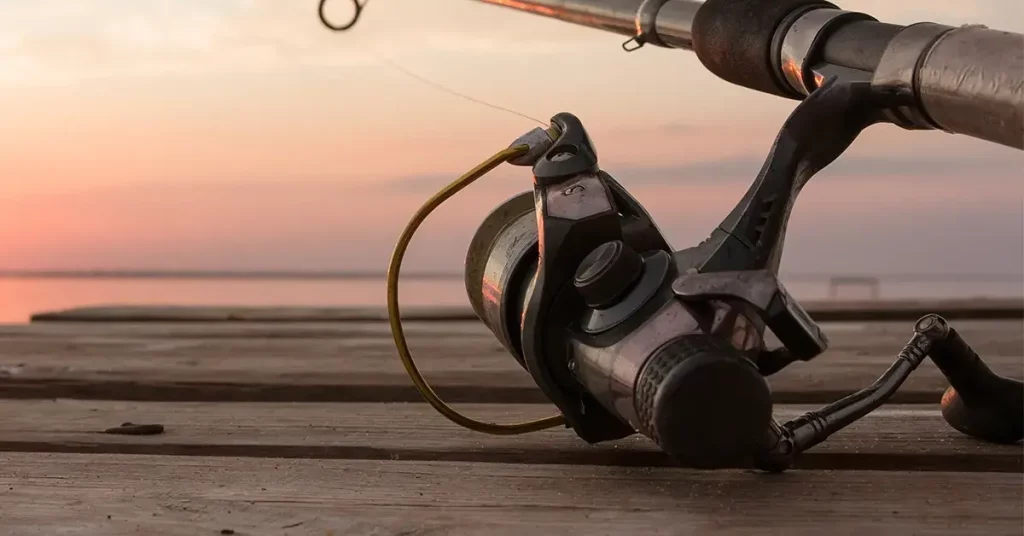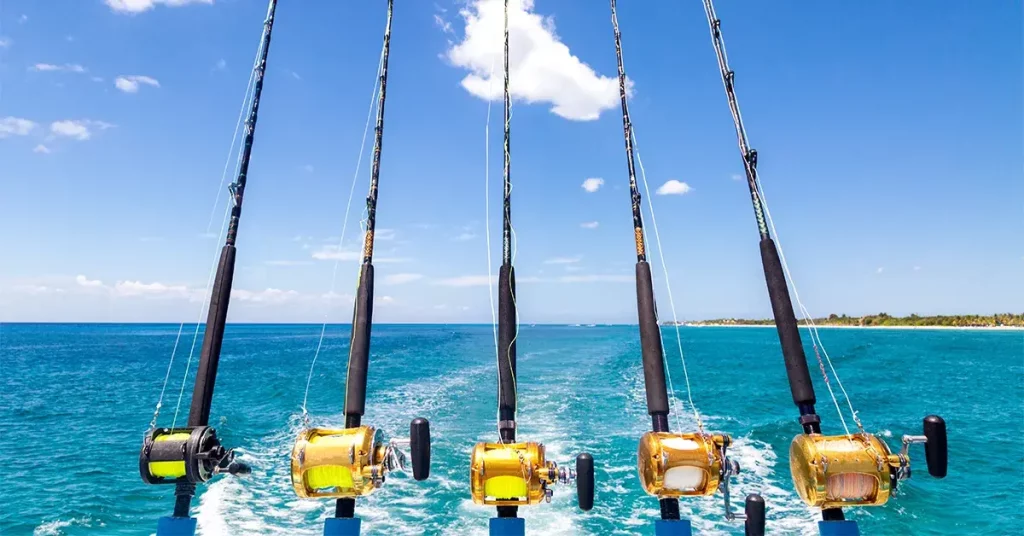Tuna are fast, muscular, and powerful. Larger tuna in the 100 lb+ range can fight for hours at a time – presenting a serious challenge for even the toughest anglers. The amount of force generated during a prolonged battle with a big tuna places severe stress on your rod and reels, so you’ll want to make sure they’re up to the task!
I got my first taste of tuna fishing on a trip to Costa Rica a few years back. We had absolutely no luck all morning – until our boat captain spotted a group of seabirds diving into the water. Before you know, we were on top of a school of Yellowfin, hooking several of them at the same time and frantically trying to get them all into the boat. What a rush!
When it comes to tuna fishing gear like tuna jigging rods, spinning, trolling, or popping gear, the old adage ‘you get what you pay for’ certainly holds true. Experienced offshore anglers are fond of saying: Do it right the first time, you’ll spend less in the long run!
With so many makes and models, picking out the right tuna jigging rod can be a challenging task. I’ll break down some of the best tuna jigging rods and reels for each fishing technique and how to pick the best one for your needs, budget, and personal preferences.
Let’s look into the best trolling, spinning, popping, and tuna jigging rods.
Quick Answer: 7 Best Tuna Jigging Rods and Fishing Reels
- Best Overall: Penn International VIS 2 Speed Fishing Reel
- Best Tuna Spinning Reel: Shimano Stella SWB
- Best Tuna Trolling Reel: Shimano Tiagra
- Best Conventional Jigging Reel: GOMEXUS Slow Pitch Jigging Reel
- Best Tuna Popping Reel: Shimano Saragosa SWA
- Best Value: Penn Fathom Lever Drag Two-Speed
- Tuna Jigging Rod & Reel Combo: Penn Squall Level Drag Reel & Rod
Best Overall: Penn International VIS 2 Speed Fishing Reel
This gorgeous 2-speed conventional reel from the renowned reel manufacturers at Penn is one of the toughest and smoothest offshore reels on the planet. It features a butter smooth drag system – even when under heavy loads. The drag control, two-speed retrieval, and strike stop are all intuitive and easy to operate without looking down at the reel.
Switching between the two gears is effortless, with a large gear change button conveniently placed at the articulation point of the handle. This enables you to switch between fast-retrieve and slow-retrieve. Fast-retrieve allows you to fish lures and jigs at a fast pace, while slow-retrieve gives you more torque when fighting a big tuna after it’s hooked.
The reel’s body and sideplates are machined from anodized aluminum, giving it an exceptional strength-to-weight ratio and virtually no flex even when spooled with heavy braid. Five shielded stainless-steel bearings provide smooth performance under a variety of conditions.
Available in both a gold and silver finish, as well as a variety of sizes, you can easily find the ideal configuration for your needs. While it’s not an inexpensive reel by any means, if you’re looking for a big game saltwater reel that can reliably bring in tuna, marlin, dorado, and other offshore giants, you’ll have a hard time beating this beauty!
Key Features
- 2-speed reel is both rugged and visually striking
- Silky smooth drag system performs well even under heavy load
- Intuitive controls are easy to operate without looking
- Anodized aluminum body and sideplates is strong and surprisingly light
- Available in sizes 16, 30, 50, 70, 80, and 130
- Made in the USA
- Machined and anodized aluminum body and side plates
- Stainless steel main and pinion gears
- Quick shift II 2 speed System
- Dura Drag System
- Versa strike adjustable strike Stop
See Pricing On:
Best Tuna Spinning Reel: Shimano Stella SWB
When it comes to big-game saltwater spinning reels, you simply can’t beat the Shimano Stella. This legendary reel is Shimano’s top-of-the-line model, making it the Rolls-Royce of their impressive line-up. You can use it as a vertical tuna jigging rod, popping plugs, or bottom fishing.
It comes in a variety of different sizes and gear ratios, from the smallest 4000, up to the beastly Bluefin-specific 30000 SWC. Shimano’s patented X-Ship enhances power transmission throughout the gears; with 11 ball bearings and 1 roller bearing providing a silky smooth retrieve, even when under heavy load. The reel produces a tremendous amount of drag (from 29 lbs. up to 62 lbs. for the largest model), which is exactly what you need when tackling offshore giants.
The Hagane metal body is built to be highly rigid, with a stiffness and impact resistance that virtually eliminates body flexing. This results in more efficient cranking power and decreases the odds of failure when you’re fighting a monster fish.
The entire reel is sealed off from the water with 12 triple-lipped sealing gaskets placed in critical locations throughout the rigid aluminum body. This protects it from the harshest saltwater spray and offers the closest thing to a perfect seal against water intrusion.
While the Stella SWB isn’t for everyone, if you’re serious about catching tuna, marlin, wahoo, and mako sharks, this high-end reel should be on your shortlist.
Key Features
- Highly rigid body eliminates body flex, and increases cranking power
- 11+1 bearings provide ultra-smooth operation
- Reel handle position can be used left or right-handed
- Heavy drag allows you to fight even the largest tuna
- Made in Japan
- Platinum Premier Service Plan
- Hagane Body
- IPX8 Waterproof Body
- Hagane Gear
- X-Rigid Gear
See Pricing On:
Best Tuna Trolling Reel: Shimano Tiagra
No list of Tuna reels would be complete without including the legendary Tiagra. Rugged, durable, and eye-catching, this heavy-duty conventional reel from Shimano is what would happen if you married a Sherman tank with a fine Swiss timepiece!
The two-speed gearing system is ultra-smooth, while the drag system allows you to make precise adjustments from just a few pounds of drag up to 70lbs at full. This allows you to present baits and lures at the optimal conditions for greater odds of successful hook-ups.
The newer ‘A’ series reels have an improved offset ergonomic power grip that increases leverage and control during prolonged battles. Every Tiagra is machined from solid 7mm pipe stock aluminum, creating a rock-solid body that retains its alignment under severe stress. Shimano’s AR-B (anti-rust bearing) stainless steel ball bearings are specially treated for improved corrosion resistance, and will last at least 10 times longer than typical stainless steel bearings in heavy saltwater usage.
Available in sizes 30, 50, 80 and a whopping 130, you can easily find the ideal reel to match your fishing style and target fish species. For stand up fishing, the 30 or 50 will work well. For use in a rod holder or fighting chair the 50, 80 or 130 would work well.
While there are certainly cheaper heavy-duty tuna reels out there, ask anyone who’s owned a Tiagra and you’ll get the same response: “worth every penny!”
Key Features
- Heavy-duty lever drag reel is ideal for trolling and live bait applications
- Rock-solid and visually striking aluminum construction
- Improved ratcheting lever drag and 2-speed gearing system
- Adjustable drag allows you to precisely set the ideal drag for the situation
- Available in sizes: 30, 50, 80, and 130
- Made in Japan
- An innovative hydrothermal drag system
- Virtually eliminates the drag setting variances
- Bring the strength and reliability of a solid aluminum frame
- Designed to fish heavier line right out of the box
- Perfectly suited to long range fishing
See Pricing On:
Best Conventional Jigging Reel: GOMEXUS Slow Pitch Jigging Reel
If you have a tuna jigging rod, you will also need a tuna jigging reel to go with it. It is always best to have suitable gear for your preferred fishing method so that you get the best experience ever.
If you are looking for a conventional tuna jigging reel to go with your tuna jigging rod, you should look into this slow-pitch reel from GOMEXUS. The price is justified by the quality of the reel, and the best thing about it is that it’s available for both left- and right-hand tuna jigging rods. It is honestly one of the best jigging reels you can find on the market right now.
Not only is this product strong, but it’s also lightweight, meaning you will not have to deal with a heavy tuna jigging rod when you install it. It’s made from carbon fiber and stainless steel, contributing to its longevity and sturdy build. No matter what you put it through, this reel will withstand the test and impress you with the results.
In addition, you can rely on this jigging reel to give you excellent torque, controller reeling, and a durable reel seat for your hand. If anything goes wrong with the reel, you can contact the manufacturing company and have them help you out, as it comes with a 1-year warranty with full coverage.
Unlike other tuna jigging reels, this one comes at a much more affordable price but has all the capabilities you need in a reel. This is why we recommend it to everyone who has a tuna jigging rod – it is honestly the best upgrade for any tuna jigging rod out there!
Key Features
- Suitable with all kinds of tuna jigging rods
- Lightweight and sturdy design
- Ergonomic handles from stainless steel
- Superior stopping power
- Made in the USA
- Made using solid 6061-T6 Marine Grade aluminum
- Tested for durability and quality
Prices pulled from the Amazon Product Advertising API on:
Product prices and availability are accurate as of the date/time indicated and are subject to change. Any price and availability information displayed on [relevant Amazon Site(s), as applicable] at the time of purchase will apply to the purchase of this product.
Best Tuna Popping Reel: Shimano Saragosa SWA
Lightweight, versatile, and tough-as-nails, this well-made spinning reel from Shimano makes an ideal reel for throwing poppers and swimbaits on the surface. It features many of the same cutting edge advancements as the Shimano Stella, but at a more affordable price point.
Shimano’s recently updated their exceedingly popular Saragosa SW to the SWA. The SWA now features the impressive infinity drive system, which increases the winding torque when under heavy load. It also cuts down on overall weight, and ups the waterproofing to an outstanding IPX8 rating.
The 5+1 roller bearings (6+1 on the two largest models) are sealed on both sides – reducing the possibility of saltwater or sand particles from impeding the bearing’s rotation. The drag system uses the same ‘X-Tough’ drag as the more expensive Stella, providing an impressive amount of drag (22 lbs. – 44 lbs.), especially when you consider its lightweight frame.
Available in eight different sizes, from 5000 up to 25000, you can easily find the ideal sized reel for your needs. For most tuna fishing, going with size 8000 to 10000 is a safe bet. If you’re after serious bluewater monsters, then consider stepping up to 20000.
If you’re looking for an all-around saltwater spinning reel capable of taking down larger saltwater species, you’ll have a hard time beating the Saragoa, especially at this price point.
Key Features
- Butter-smooth, well built, and reasonably priced
- Infinity drive system
- IPX8 waterproof, sealed bearings prevent saltwater damage
- Excellent X-Tough drag system
- Works well for popping and jigging
- Manual bail
- Infinity Drive: The new main shaft supporting structure improves winding torque by 30% while allowing incredibly smooth and light rotation. This essentially means having the benefit of a quick line retrieve HG ratio reel but with the power and winding torque similar to that of a PG.
- X-Protect: By combining our water repellent coating and our specially designed, water channeling, labyrinth construction, X-Protect provides high-level water resistance without sacrificing light gear and rotor rotation.
- IPX8 Water Resistance to create long-lasting durability without sacrificing performance
- Hagane Gear: With amazing strength and durability, the HAGANE Gear is at the very heart of the reel. Shimano, through the application of state-of-the-art technologies, gives you the long-lasting smoothness and pleasure that you feel when you first use a reel, over and over again. No cutting work is applied to the teeth of the drive gear. Instead the entire surface is calculated in minute detail by special 3D design and then formed by Shimanos cold forging technology
- Cross Carbon Drag: This drag material provides a wider range of drag settings, along with the smoothest Shimano drag performance ever
See Pricing On:
Best Value: Penn Fathom Lever Drag Two-Speed
If you’re looking for a highly capable tuna jigging rod without breaking the bank, the 2-speed Penn Fathom Lever Drag makes an excellent option. It features a full metal body and side plates, a forged and machined aluminum spool, double-dog ratchet anti-reverse, plus 5 shielded stainless steel ball bearings.
For a price tag of just over $200, you get a well-built 2-speed gearbox, allowing you to quickly toggle between high-gear for quick retrieves and low-gear for increased torque when fighting larger fish. Penn also includes its excellent Dura Drag system which virtually eliminates snags and hesitation, even when under extreme loads.
Like other lever drag conventional reels, the sliding lever allows you to make precise adjustments to the drag settings – so you can present your bait or lure under the ideal conditions. This tuna jigging rod is extremely easy to cast with and operates so smoothly, you’d think it would cost double.
Key Features
- Durable, smooth, and easy to use tuna jigging rod
- All metal construction, 2-speed gearing, and lever drag
- Excellent value
- Available is sizes 15, 25, 30, 40, and 60
- Available in both right-hand and left-hand retrieve
- Used by professionals worldwide
- Made using only the highest quality components
- Tested for quality and durability
See Pricing On:
Tuna Jigging Rod and Reel Combo: Penn Squall Level Drag Reel & Rod
If you’re looking for a simple all-in-one tuna jigging rod and reel combo for catching tuna, dorado, wahoo, and other offshore species, the Penn Squall Level Drag combo makes an excellent choice. Its lightweight and ergonomic design is perfect for stand-up fishing, or it can work just as well in a rod holder for trolling.
The reel frame and sideplates are made from lightweight and durable graphite, providing solid performance in a surprisingly lightweight package. A forged and machined aluminum spool, as well as a stainless steel main and pinion gears, comprise the rest of the reel’s body. Penn includes the same Dura-Drag system that they use in their higher-priced International and Fathom reels – so you’re still getting a top of the line drag system in an affordable package.
The one-piece tuna jigging rod is made from lightweight and sensitive graphite, providing excellent strike detection ability and feel. The combo is available in several different configurations, from a size 30 reel + medium rod up to a size 60 reel + heavy rod.
Keep in mind this combo is meant to be a starter tuna jigging rod and reel setup, don’t expect to get top-of-the-line performance from it.
Key Features
- Lightweight, capable tuna jigging rod and reel combo for catching nearshore and offshore species
- Lever drag reel includes Penn’s excellent Dura-Drag system
- 6 stainless steel bearings
- Lightweight and sensitive solid graphite rod
- Lightweight graphite frame and sideplates
- Forged and machined aluminum spool with line capacity rings
- Stainless-steel main and pinion gears
- Dura-Drag system. Max Drag Pounds - 30 Pounds | 13.6kg
- 6 stainless-steel bearings
- Silent double-dog anti-reverse
- Lightweight graphite frame and sideplates.
- Stainless main and pinion gears.
- Sealed Dura-Drag rings.
- Silent instant anti-reverse.
- Switch-blade harness lugs
View Pricing On:
How to pick the best tuna jigging rod or reel
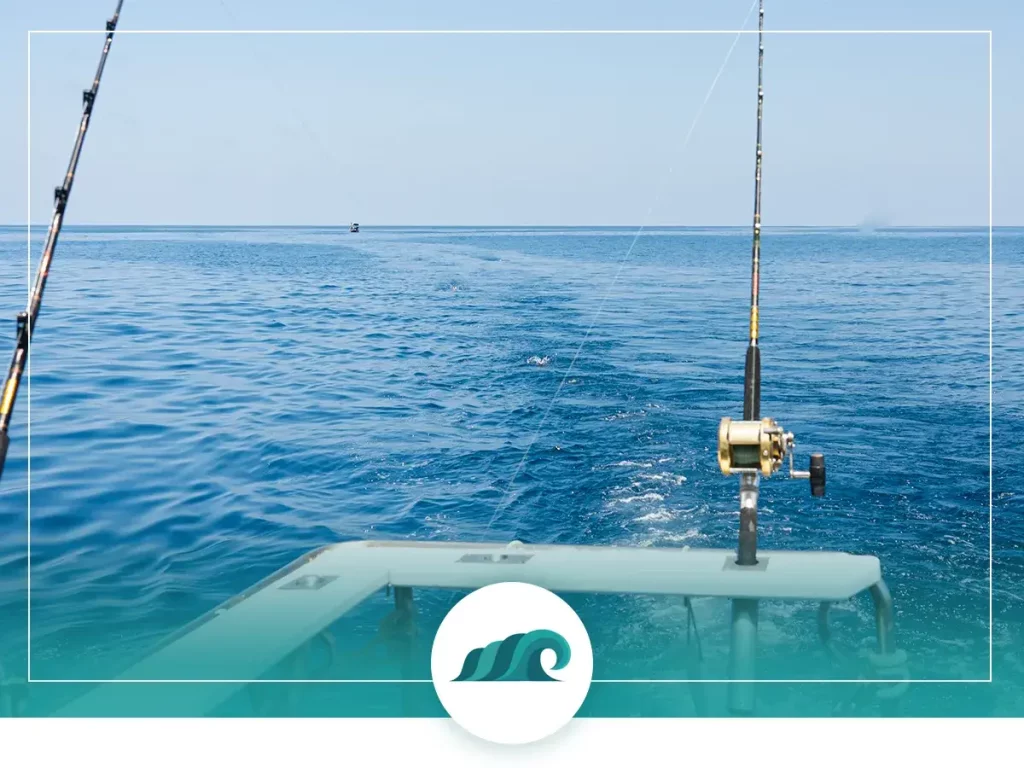
With so many features, makes, and models, choosing a tuna jigging rod or reel can be a daunting task. I’ll break down the important features and factors you need to understand when choosing the right tuna jigging rod or reel for your needs:
Species
There are three main tuna species targeted by anglers in the US, Mexico, and the Caribbean: Yellowfin, Bluefin, and Skipjack.
Yellowfin are highly sought after by both sport and commercial fishermen. They’re powerful, put up an incredible fight, and are one of the best tasting fish on the planet. They range from 10 – 15 lbs. for juveniles, sometimes called ‘footballs’, up to 200 lbs. or more for mature adult fish.
Depending on your location, Yellowfin can vary significantly in terms of size and weight. In California, most Yellowfin taken weigh between 30 and 50 pounds, but 200-pound fish are occasionally caught. This means you’ll need to match your tuna jigging rod, reed, and tackle to the size of Yellowfin you’re targeting.
Bluefin is another highly sought after tuna species, and grow significantly larger than their Yellowfin cousins. Fully grown adult Bluefin typically weigh in the 500-pound range, but fish over 1000 pounds have been caught.
When you’re targeting Bluefin, you’ll want to beef up your tackle and tuna jigging rod to match their size. Generally the largest reel sizes with 50 lbs+ max drag work well for Bluefin, although juvenile Bluefin can be caught on lighter tackle and reels.
Skipjack is a smaller tuna species common to tropical, subtropical, and warm temperate waters. In the western Atlantic Ocean, they’re found from Massachusetts down to Brazil. In the Pacific, they’re found all along the west coast, as well as around U.S. pacific islands.
They’re significantly smaller than the other two tuna species, weighing just 40 pounds when fully grown. While they’re not as popular among sport fishermen as Yellowfin or Bluefin, they’re abundant, taste great, and can put up a great fight. When you’re targeting these tuna, you can use much lighter reels, tackle, and tuna rods.
Reel Type
There are two main reels used for catching tuna and other large offshore species: conventional reels and spinning reels.
Conventional reels look a lot like the smaller baitcasting reels that most anglers are familiar with, with a few important distinctions. Conventional tuna reels are designed for trolling bait, bottom fishing, and pulling large fish up from the depths. Their design is more about power, line capacity, and transferring maximum pressure to big prey with minimum stress on your equipment.
Unlike many baitcasting reels, many conventional reels lack built-in backlash protection and require you to use thumb control to prevent backlashes. You can still cast effectively with conventional reels; it just requires a little practice. If you plan to fish primarily by trolling or deep dropping, then a conventional reel is the way to go.
Spinning reels for offshore fishing are essentially beefed-up versions of the spinning reels most of us are familiar with. They feature heavy max drags, rigid bodies, and large line capacities for fighting with tuna and other offshore giants. They also typically have excellent water resistance – preventing saltwater intrusion and corrosion.
Spinning tuna reels are ideally suited for casting poppers and baits on the surface and bottom fishing, but they are also great for using with a tuna jigging rod.
Drag
Drag is an important consideration whenever you’re dealing with large, muscular, and powerful fish like tuna. Large tuna have enough strength to overpower inferior reels, so you’ll need a fair bit of drag when targeting them.
Reels come with various drag systems (lever drag, star drag) as well as max drag ratings. Generally, when you’re targeting tuna up to around 100 lbs, you can use reels that put out 20 lbs. of drag. If you’re targeting big fish over 200 lbs, you’ll need a reel that can reliably produce 30 – 40 lbs. of drag.
Keep in mind that max drag is an indication of the absolute maximum drag a reel can produce, but it’s not the ideal drag for that reel.
You want a max drag that’s higher than the intended drag settings by a factor of 1.5 or so. So, if you’re planning on using 20 – 30 lbs. of drag, you’ll want a reel with a 40 – 50 lbs. max drag. It’s kind of like towing capacity in a pickup truck – if the max capacity is 13,000 pounds, loading the bed up with 12,999 pounds will increase the chance of failure over time.
Most manufacturers recommend setting the drag to 1/4 to 1/3 of your line strength for trolling. So if you’re fishing with 80lb test, you’d set the drag to 20 to 30 lbs. This is just a general guideline though, and you can play around a bit here.
2 Speed vs. 1 Speed Gears
Heavy-duty conventional reels generally come in either 2-speed or 1-speed configurations. 2-speed reel allow you to toggle between a high gear for quickly reeling in line, and a low gear for a slower, more powerful retrieve. Having two gears is especially useful when fighting large, powerful fish like tuna. You can use the high gear for quickly retrieving baits and lures on the surface, and the low gear for extra power once you’ve hooked a serious cow!
1-speed reels have only a single gear, so they lack the versatility of 2-speed reels. While 2-speed reels used to be available only in the highest-end reels, manufacturers are making them in increasingly affordable options.
I’d generally recommend going with a 2-speed reel, as they’ll give you more options when fighting big tuna, and you can easily find a solid 2-speed for just a few bucks more than a similar 1-speed.
Size
Picking the right reel size is largely a function of the fish you’re targeting. If you’re fishing for smaller 30 lbs. tuna you can get away with pretty much any decent saltwater reel. Once you step up to larger fish, you’ll want to make sure you’re matching the reel size to the fish.
Also, consider the line capacity when picking out a reel. If you’re planning to fish in deep water, or you’re fishing from an anchored boat, you’ll want to go with a reel with a larger 750+ yard capacity.
Budget
Lastly, your budget will probably plan a major role in choosing a reel. Tuna gear isn’t cheap, so if you want a top-quality reel, get ready to drop a good chunk of change.
Keep in mind that a high-end tuna reel is a long term investment – it will pay dividends over time. These reels will outlast and outperform cheaper models by many years, paying for themselves over time. Also, if you want to resell them at some point, they tend to retain their value and sell for close to retail prices.
If you can afford to splurge on a high-end reel, you’ll get a piece of equipment that’s smoother, lighter, longer-lasting, and more comfortable to use. This results in more tuna in the boat!
If you’re interested in a new reel, check out my breakdowns of fishing line spoolers, and fishing reel grease and oil to go along with your new reel.
Fishing Methods
One of the things that can make a huge difference when you are fishing is the fishing method. Depending on your preferred method, you can choose the best tuna jigging rod and reel.
You can choose between spinning, trolling, popping, and tuna jigging rods and reels. But before you do, let’s look into the difference between the fishing methods.
Tuna jigging is the most convenient fishing method. Using a tuna jigging rod, you quickly raise the rod as soon as you feel the fish take the bait. You retrieve it and put the rod back into the water. This is pretty simple and a great place to start for beginners.
Using a tuna jigging rod, you can also try trolling, which is when you tow the tuna behind your boat or vessel. The same tuna jigging rod can help you in spinning, which is when you put the metal bait in the water and wait for a tuna to get hooked. You might move it slightly through the water to tempt the fish at first.
Tuna popping is similar to tuna jigging, so you can always try doing it with a tuna jigging rod. Popping requires you to move the tuna on the water’s surface with swift movements.
As you can see, the gear needed for each fishing method is either the same or very similar. So, depending on your needs and preferences, you can choose gear that will make tuna fishing much more convenient for you.

